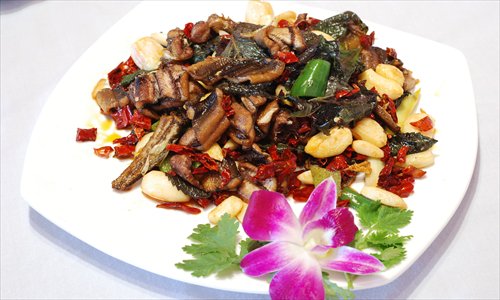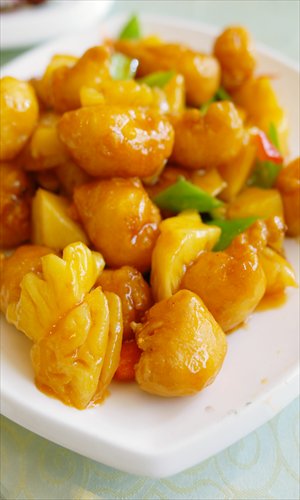Editor's note
The ancient Chinese created an agricultural solar system - still in use today - that is based upon their observation of crops, climate, astrology, and the study of animal and plant life cycles. The system guided farmers as to when to sow seeds and when to harvest them, and this system has now been in place for more than 2,000 years.
Today, with advances in science and technology, agriculture depends less on this ancient wisdom. But this seasonal calendar still operates as a reference guide for gourmands to seek out the best times for seasonal delicacies and for health experts to plan nutritious diets.
In a single year, the system features 24 "solar terms" - each lasting one day and occurring every two weeks. Each has its own name and characteristics. The Global Times is presenting a weekly series examining which foods and delicacies are best enjoyed during these periods, as well as tips on preserving general health.
The solar term of xiaoshu, or "Lesser Heat," falls on July 7 this year, and indicates that the summer heat has well and truly arrived. This usually marks the end of the "plum rain" and the beginning of the dry, hot season in the Yangtze River Delta region. In the north of China meanwhile, the date marks the move into the area's rainy season.
Traditions and customs associated with xiaoshu vary greatly in different parts of the country. People in northern China eat jiaozi, while in some parts of Shandong Province, cucumber and boiled eggs are enjoyed. Xuzhou, in Jiangsu Province, is known for the habit of local people eating mutton, while Taiwan natives prefer to eat lots of mangoes.
The Global Times has selected some mouthwatering dishes typically enjoyed during this period and which can be easily prepared at home.

Finless eel braised in soy sauce
There is a saying among people in the Yangtze River Delta region that finless eel, around the time of xiaoshu, is as nutritious as ginseng, with fans of the dish believing the flesh to be at its most tender and tasty during this period. According to the Compendium of Materia Medica compiled during the Ming Dynasty (1368-1644), finless eels are excellent for replenishing the blood, reducing inflammation and dispelling toxins.
Ingredients:
500 grams finless eel, five dry red peppers, two bulbs of garlic, two green peppers, 20 grams spring onion, 2 grams ginger, one tablespoon cooking wine, one teaspoon MSG, one tablespoon soy sauce, one teaspoon salt, one teaspoon white sugar, and one teaspoon ground pepper powder
Method:
Remove the intestines and entrails of the finless eel, discard and cut the rest into two-inch-long strips
Boil the strips in water for 50 to 60 seconds, pick them out and then wash with fresh water
Cut the spring onion and green pepper into cubes, and slice the ginger
Stir-fry the spring onion, ginger, dry red pepper and garlic for 20 seconds on a high heat
Add the finless eel and stir-fry for another 30 seconds
Add the soy sauce, salt, ground pepper powder, sugar, cooking wine and enough boiling water so that this liquid is enough to completely cover the meat; reduce the heat after it has come to the boil
When the meat is well done, add the green pepper and MSG and boil until all the liquid has boiled out

Sweet-and-sour pork with pineapple
Dishes cooked with fruit are a delight to the taste buds around, and after, xiaoshu. The most commonly-used fruits in these dishes are pineapple, dragon fruit and lychee. Although pineapples are available during every season, the best-quality pineapples are said to be those picked in summer from June to August. Pineapple makes an ideal seasonal choice because its sour taste helps to stimulate some people's poor appetite during the summer.
Ingredients:
200 grams pork fillet, 100 grams pineapple, one green pepper, one red pepper, one egg, 10 grams garlic, 10 grams spring onion, 10 grams ginger, one tablespoon light soy sauce, two teaspoon rice wine, one teaspoon salt, three tablespoon starch, half tablespoon white pepper powder, four teaspoon white vinegar, 15 grams white sugar, 40 grams ketchup, 50 grams flour, and 400 milliliters seed oil
Method:
Dice the pork fillet into 1-inch-long pieces, cut the green pepper and red pepper into diamond shapes, cut the spring onion into cubes and slice the ginger and garlic
Put the pork pieces into a bowl, and add two teaspoon light soy sauce, the prepared white pepper powder, the rice wine and the salt to marinate the pork
Beat the egg in a bowl and pour it onto the pork and make sure all the pork is covered with egg
Cover the pork pieces with flour
Fry the pork pieces in boiling oil, and then turn down the heat when they start to become crispy after about two minutes
Stir-fry the prepared ginger, spring onion, garlic and peppers for 20 seconds
Add white vinegar, ketchup, white sugar, and 200 milliliter warm water to this mixture and when the sauce boils, add the starch in
Add the fried pork pieces and fresh pineapple pieces to the sauce when it becomes sticky, stir-fry for a little longer and the dish is ready to serve
